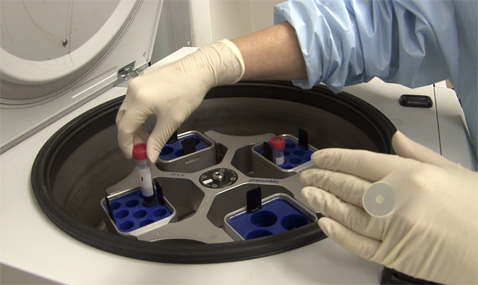
Blood Wars Laboratory Protocol
Blood Wars Laboratory Protocol developed at SymbioticA with the help of Dr. Luis Filgueira
Extract blood 5ml – use Heprin vial for blood collection
Separating Blood
Add 5 ml of Ficoll in each of two separate vials (labeled)
Add 3 ml of blood into each vial with the Ficoll (add blood slowly and at an angle)
Put in centrifuge for:
20degrees 4000rpm 15minutes
Take vials out of centrifuge
Use pipette to draw out white blood cells and some plasma (about 1cm above the
red blood cells – will be about 4‐5ml)
Put into another vial
Add 5ml of PBS medium to each vial (total about 9.5ml in each)
Shake vials to mix materials
Put back in centrifuge:
20degrees 1600rpm 12minutes
Take vials out of centrifuge
Empty most of liquid from each vial into waste container
“Break” the remaining cells in each vial
Add .5ml of RPMI medium to each vial
Adding Cell Stains
1 micro liter of Green stain (Celltracker Green CMFDA, C‐2925, IMG, by
Invitrogen) added to one vial
3 mico liters of Red stain (Celltracker Orange CMTMR, C‐2927, IMG, by
Invitrogen) added to the other vial
(Make note of which is which)
1 micro liter of DAPI (which stains the nuclei of the cells – blue‐ with UV)
(DAPI is mixed 5 micrograms per ml)
Put in incubator ‐ Incubate vials in 34‐37degrees for 15 minutes
Take vials out of incubator
Add 10 ml to each vials of RPMI medium
Shake to mix
Centrifuge both vials:
20degrees 1000rpm 7minutes
Take vials out of centrifuge
Empty most of liquid from each vial into waste container
“Break” the remaining cells in each vial
Add 2ml of RPMI medium to one vial
(Can add one drop of antibiotic in vial)
Draw the material from that vial into pipette and mix with material from second vial
Mix materials by drawing into pipette and back
Put mixed materials into small petri dish –take to microscope
Blood Wars Microscope Protocol
Microscope protocol developed at SymbioticA and UWA with the help of Guy Ben-Ary.
Equipment
• Microscope – fully motorized inverted Nikon Ti
• Objective used was Nikon PL APO 60x (Oil) 1.40 numerical aperture and 0.13 Millimeters working distance
• Camera – CoolSNAP EZ
• Cubes –
Ultraviolet Excitation Filter Block UV-2A Specifications:
• Excitation Filter Wavelengths: 330-380 nanometers (bandpass, 355 CWL)
• Dichromatic Mirror Cut-on Wavelength: 400 nanometers (longpass, LP)
• Barrier Filter Wavelengths: 420 nanometer cut-on (longpass, LP)
Blue Excitation Filter Block B-2A Specifications:
• Excitation Filter Wavelengths: 450-490 nanometers (bandpass, 470 CWL)
• Dichromatic Mirror Cut-on Wavelength: 500 nanometers (longpass, LP)
• Barrier Filter Wavelengths: 515 nanometer cut-on (longpass, LP)
Green Excitation Filter Block G-2A Specifications:
• Excitation Filter Wavelengths: 510-560 nanometers (bandpass, 535 CWL)
• Dichromatic Mirror Cut-on Wavelength: 565 nanometers (longpass, LP)
• Barrier Filter Wavelengths: 590 nanometer cut-on (longpass, LP)
• Software NIS Element AR
Method
- Cultures were grown in 35 MM Petri dish with a glass bottom (FluoroDish by World Precision Instruments, Inc.)
- The microscope had an enclosure that was heated to 37 degrees Celsius
- Dishes were placed in the heated enclosure and in a 5 % CO2 chamber on the microscope stage.
- The optical configurations (camera and microscope settings) were set for each one of the wave lengths (red blue and green)
- ND filters were used (Natural density filters) to reduce light levels to the minimum needed for observation while increasing camera exposure time. This technique was adopted so that less light will fluoresce on the cells so less bleaching occurs. We usually used the ND 4 or 8 (which means light intensity of ¼ or 1/8 respectively.
- The Microscope “Perfect Focus System” was turned on so drift of focus during the experiment will be avoided.
- Experiment was set up to run for 24 hours capturing 3 images (Red green and blue) every 60 seconds.
- The order of capturing per exposure time was – Blue Red and Green.
- Results were exported using Cinapec codec with 20 milliseconds intervals between the frames.